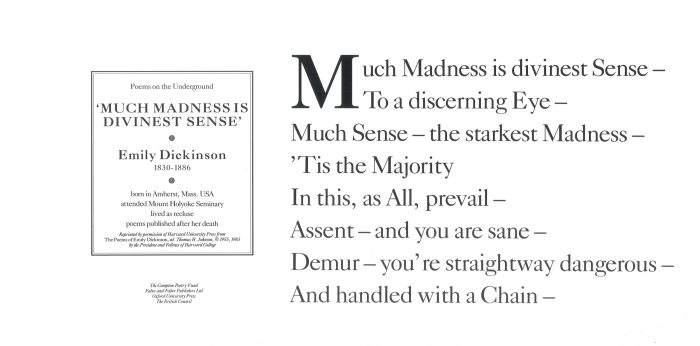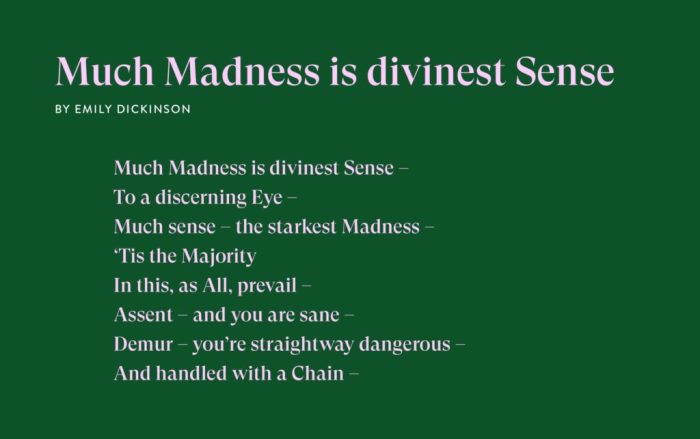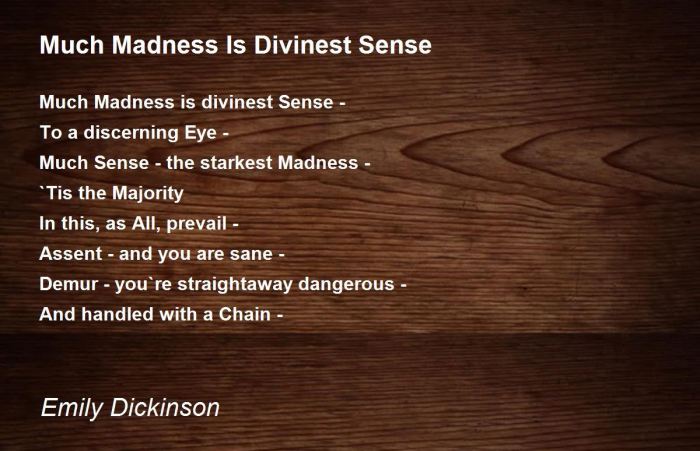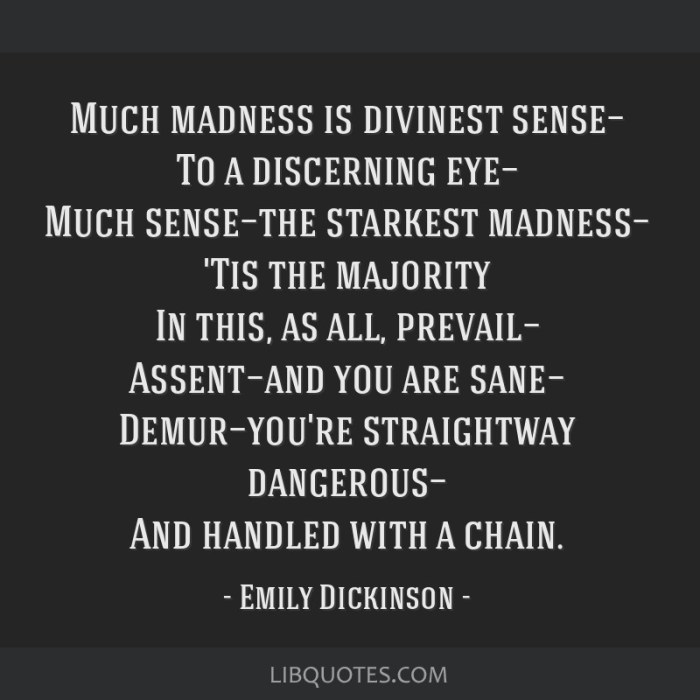Much madness is divinest sense paraphrase – Delving into the captivating realm of “Much Madness Is Divinest Sense,” this discourse embarks on an intellectual odyssey, unraveling the enigmatic connection between madness and wisdom. This exploration promises to challenge conventional notions, offering profound insights into the complexities of the human psyche.
The paradoxical nature of madness, often perceived as a deviation from reason, is brought into sharp focus. We shall delve into the historical and cultural contexts that have shaped the definition of madness, recognizing its subjective and multifaceted nature.
Madness as Wisdom

Madness, often perceived as a state of irrationality and mental instability, paradoxically holds a profound connection to divine sense. Throughout history and literature, numerous examples illustrate the symbiotic relationship between madness and profound insights. From the oracles of ancient Greece to the visionaries of the Renaissance, individuals deemed mad have often been revered as conduits to the divine.
Madness, in its unbridled nature, liberates the mind from conventional constraints, allowing for unconventional perspectives and insights. In the realm of literature, Hamlet’s feigned madness enables him to expose the corruption and deceit within the Danish court, while Ophelia’s descent into madness unveils the hidden truths and complexities of love and loss.
The Subjective Nature of Madness, Much madness is divinest sense paraphrase
The definition of madness is not absolute but rather a subjective construct influenced by cultural and historical factors. Societies throughout time have established their own criteria for labeling individuals as mad, often based on prevailing norms and beliefs. This subjectivity has led to the unjust labeling and mistreatment of those who deviate from societal expectations.
In the 19th century, for instance, hysteria was considered a form of female madness, while in the 20th century, homosexuality was classified as a mental disorder. These examples highlight the malleable nature of madness and its dependence on societal norms.
Madness as a Source of Creativity
Madness has been a muse for countless artists, writers, and musicians throughout history. Its unfettered nature allows for the exploration of unconventional ideas and the creation of innovative works. Salvador Dalí’s surrealist paintings, for example, were inspired by his dreams and visions, while Vincent van Gogh’s vibrant and emotionally charged works were influenced by his struggles with mental illness.
However, it is important to acknowledge the potential risks associated with using madness for creative purposes. The pursuit of artistic inspiration through madness can be a perilous path, often leading to self-destruction and further mental instability.
Madness and Spirituality
Madness has long been intertwined with spiritual experiences. In many cultures, individuals experiencing madness are seen as having a connection to the divine or the supernatural. Shamans, for instance, often induce a state of trance or madness to access the spirit world and communicate with deities.
Religious rituals and practices often incorporate elements of madness, such as ecstatic dancing, chanting, and self-mortification. These practices are believed to induce a state of altered consciousness, allowing participants to transcend ordinary reality and connect with the divine.
The Stigma of Madness
Throughout history, madness has carried a heavy stigma, contributing to the isolation and discrimination faced by those who experience it. This stigma is rooted in fear, ignorance, and the desire to maintain social order.
The stigma of madness has led to the institutionalization and mistreatment of those deemed mad. In the past, individuals with mental illness were often confined to asylums, where they were subjected to inhumane conditions and treatments.
Answers to Common Questions: Much Madness Is Divinest Sense Paraphrase
What is the essence of the “Much Madness Is Divinest Sense” concept?
This concept explores the paradoxical notion that madness, often seen as a departure from reason, can paradoxically lead to profound insights and wisdom.
How does culture influence the definition of madness?
Cultural norms and beliefs play a significant role in shaping societal perceptions of madness, leading to varying definitions and treatments across different cultures and time periods.
Can madness be a source of creativity?
Yes, madness has been linked to enhanced creativity in some individuals, providing unique perspectives and unconventional thinking patterns that can foster artistic expression and innovation.


